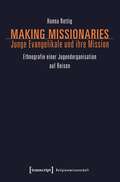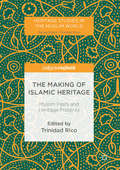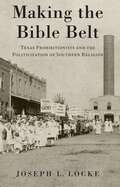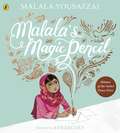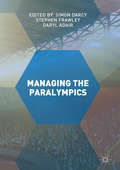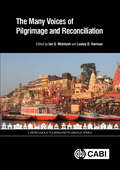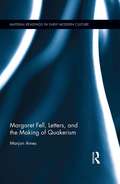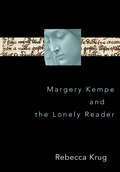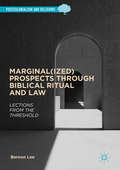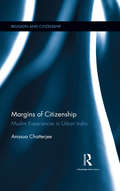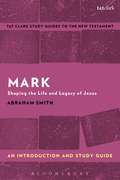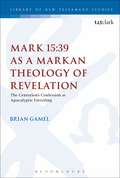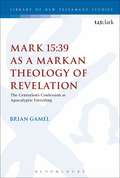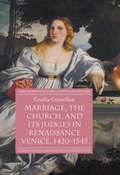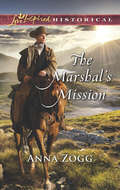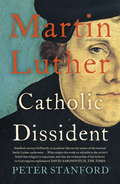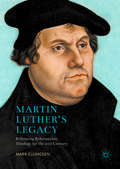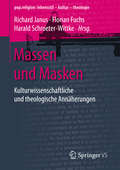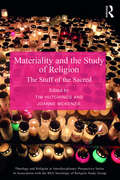- Table View
- List View
Making Missionaries - Junge Evangelikale und ihre Mission: Ethnografie einer Jugendorganisation auf Reisen (Religionswissenschaft #9)
by Hanna RettigDas »College« ist eine temporär und total organisierte Gruppe junger evangelikaler Christ_innen in missionarischer Ausbildung. Die Gruppe lebt und reist im engen Verbund und bringt sich hervor in einem faszinierenden Verhältnis zwischen Abgrenzung von der und missionarischer Ausrichtung auf die Welt. Wie dieses Verhältnis hergestellt und bearbeitet wird, wie ein Innen sich konstituiert und wie das College ein Außen erreicht, wie es aus der Welt tritt und in die Welt geht - das ist Thema dieser Studie. Hanna Rettig hat als teilnehmende Beobachterin mit dem College gelebt, ist in verschiedene Länder mitgereist, hat Lernen und Missionieren ethnografisch begleitet. Ihre Analyse bietet neue Einblicke in evangelikales Leben und Missionieren in Deutschland und darüber hinaus.
The Making of Islamic Heritage: Muslim Pasts and Heritage Presents
by Trinidad RicoThis book is open access under a CC BY 4.0 license. Offering key insights into critical debates on the construction, management and destruction of heritage in Muslim contexts, this volume considers how Islamic heritages are constructed through texts and practices which award heritage value. It examines how the monolithic representation of Islamic heritage (as a singular construct) can be enriched by the true diversity of Islamic heritages and how endangerment and vulnerability in this type of heritage construct can be re-conceptualized. Assessing these questions through an interdisciplinary lens including heritage studies, anthropology, history, conservation, religious studies and archaeology, this pivot covers global and local examples including heritage case studies from Indonesia, Egypt, Saudi Arabia, Iran, Jordan, and Pakistan.
The Making of Islamic Heritage: Muslim Pasts and Heritage Presents
by Trinidad RicoThis book is open access under a CC BY 4.0 license. Offering key insights into critical debates on the construction, management and destruction of heritage in Muslim contexts, this volume considers how Islamic heritages are constructed through texts and practices which award heritage value. It examines how the monolithic representation of Islamic heritage (as a singular construct) can be enriched by the true diversity of Islamic heritages and how endangerment and vulnerability in this type of heritage construct can be re-conceptualized. Assessing these questions through an interdisciplinary lens including heritage studies, anthropology, history, conservation, religious studies and archaeology, this pivot covers global and local examples including heritage case studies from Indonesia, Egypt, Saudi Arabia, Iran, Jordan, and Pakistan.
Making the Bible Belt: Texas Prohibitionists and the Politicization of Southern Religion
by Joseph L. LockeMaking the Bible Belt upends notions of a longstanding, stable marriage between political religion and the American South. H.L. Mencken coined the term "the Bible Belt" in the 1920s to capture the peculiar alliance of religion and public life in the South, but the reality he described was only the closing chapter of a long historical process. Into the twentieth century, a robust anticlerical tradition still challenged religious forays into southern politics. Inside southern churches, an insular evangelical theology looked suspiciously on political meddling. Outside of the churches, a popular anticlericalism indicted activist ministers with breaching the boundaries of their proper spheres of influence, calling up historical memories of the Dark Ages and Puritan witch hunts. Through the politics of prohibition, and in the face of bitter resistance, a complex but shared commitment to expanding the power and scope of religion transformed southern evangelicals' inward-looking restraints into an aggressive, self-assertive, and unapologetic political activism. The decades-long religious crusade to close saloons and outlaw alcohol in the South absorbed the energies of southern churches and thrust religious leaders headlong into the political process--even as their forays into southern politics were challenged at every step. Early defeats impelled prohibitionist clergy to recast their campaign as a broader effort not merely to dry up the South, but to conquer anticlerical opposition and inject religion into public life. Clerical activists churned notions of history, race, gender, and religion into a powerful political movement and elevated ambitious leaders such as the pugnacious fundamentalist J. Frank Norris and Senator Morris Sheppard, the "Father of National Prohibition." Exploring the controversies surrounding the religious support of prohibition in Texas, Making the Bible Belt reconstructs the purposeful, decades-long campaign to politicize southern religion, hints at the historical origins of the religious right, and explores a compelling and transformative moment in American history.
Malala's Magic Pencil
by Malala Yousafzai KerascoëtAs a child in Pakistan, Malala made a wish for a magic pencil that she could use to redraw reality. She would use it to give gifts to her family, to erase the smell from the rubbish dump near her house, to sleep an extra hour in the morning. As she grew older, Malala wished for bigger and bigger things. She saw a world that needed fixing. And even if she never found a magic pencil, Malala realized that she could still work hard every day to make her wishes come true.This beautifully illustrated picture book tells Malala's story, in her own words, for a younger audience and shows them the worldview that allowed her to hold on to hope and to make her voice heard even in the most difficult of times.
Managing the Paralympics
by Simon Darcy Daryl Adair Stephen FrawleyThis book critically examines the planning, management, and operations of the world’s premier event for Para sport athletes. Noting a lack of research into how these games are planned and managed, the authors of this contributed volume discuss how the Paralympics are essentially different to the Olympics and what this means for their management. Managing the Paralympics explores how the organizers and connected stakeholders effectively organize and deliver the Paralympics, taking into account what has been learned from previous events. Including emergent models of best practice from event management, project management and sport management literature, the book gives an insight into the planning of one of the world’s biggest sporting events that encompasses ten impairment types and multiple sport classes within sports.
Many Voices of Pilgrimage and Reconciliation, The (CABI Religious Tourism and Pilgrimage Series)
by Tahar Abbou Lucinda Carspecken John Hornblow Jenny Boyack Sonika Jain Nanna Natalia Jørgensen Steven Muir Zülfükar Özdogan Cindy Pavlinac E. Moore Quinn Mari-Johanna Rahkala-Simberg Varada Sambus Patricia A. Sayre Daniel J. Simons Chadwick Co Su Sara TerreaultReviewing peace and reconciliation, secular pilgrimages, and international perspectives on sacred journeys, this book offers the reader an opportunity to encounter multiple voices and viewpoints on one of the most ancient practices of humankind. With an estimated third of all international travellers now undertaking journeys anticipating an aspect of transformation (the hallmark of pilgrimage), this book includes both spiritual and non-spiritual voyages, such as journeys of self-therapy, mindfulness and personal growth. It also: - Provides a multidisciplinary perspective, covering themes such as gender, human rights, equality, the environment, peace, history, literature, and politics - Reflects the rich diversity and multiple meanings of pilgrimage through an international writer team spanning four continents - Includes case studies of pilgrimage in action from around the world An innovative and engaging addition to the pilgrimage literature, this book provides an important resource for researchers of religious tourism and related subjects.
Margaret Fell, Letters, and the Making of Quakerism (Material Readings in Early Modern Culture)
by Marjon AmesIntensely persecuted during the English Interregnum, early Quakers left a detailed record of the suffering they endured for their faith. Margaret Fell, Letters, and the Making of Quakerism is the first book to connect the suffering experience with the communication network that drew the faithful together to create a new religious community. This study explores the ways in which early Quaker leaders, particularly Margaret Fell, helped shape a stable organization that allowed for the transition from movement to church to occur. Fell’s role was essential to this process because she developed and maintained the epistolary exchange that was the basis of the early religious community. Her efforts allowed for others to travel and spread the faith while she served as nucleus of the community’s communication network by determining how and where to share news. Memory of the early years of Quakerism were based on the letters Fell preserved. Marjon Ames analyzes not only how Fell’s efforts shaped the inchoate faith, but also how subsequent generations memorialized their founding members.
Margaret Fell, Letters, and the Making of Quakerism (Material Readings in Early Modern Culture)
by Marjon AmesIntensely persecuted during the English Interregnum, early Quakers left a detailed record of the suffering they endured for their faith. Margaret Fell, Letters, and the Making of Quakerism is the first book to connect the suffering experience with the communication network that drew the faithful together to create a new religious community. This study explores the ways in which early Quaker leaders, particularly Margaret Fell, helped shape a stable organization that allowed for the transition from movement to church to occur. Fell’s role was essential to this process because she developed and maintained the epistolary exchange that was the basis of the early religious community. Her efforts allowed for others to travel and spread the faith while she served as nucleus of the community’s communication network by determining how and where to share news. Memory of the early years of Quakerism were based on the letters Fell preserved. Marjon Ames analyzes not only how Fell’s efforts shaped the inchoate faith, but also how subsequent generations memorialized their founding members.
Margery Kempe and the Lonely Reader
by Rebecca KrugSince its rediscovery in 1934, the fifteenth-century Book of Margery Kempe has become a canonical text for students of medieval Christian mysticism and spirituality. Its author was a fifteenth-century English laywoman who, after the birth of her first child, experienced vivid religious visions and vowed to lead a deeply religious life while remaining part of the secular world. After twenty years, Kempe began to compose with the help of scribes a book of consolation, a type of devotional writing found in late medieval religious culture that taught readers how to find spiritual comfort and how to feel about one's spiritual life. In Margery Kempe and the Lonely Reader, Rebecca Krug shows how and why Kempe wrote her Book, arguing that in her engagement with written culture she discovered a desire to experience spiritual comfort and to interact with fellow believers who also sought to live lives of intense emotional engagement.An unlikely candidate for authorship in the late medieval period given her gender and lack of formal education, Kempe wrote her Book as a revisionary act. Krug shows how the Book reinterprets concepts from late medieval devotional writing (comfort, despair, shame, fear, and loneliness) in its search to create a spiritual community that reaches out to and includes Kempe, her friends, family, advisers, and potential readers. Krug offers a fresh analysis of the Book as a written work and draws attention to the importance of reading, revision, and collaboration for understanding both Kempe’s particular decision to write and the social conditions of late medieval women’s authorship.
Marginal(ized) Prospects through Biblical Ritual and Law: Lections from the Threshold
by Bernon LeeThis book follows a reader’s logic of association through a series of overlapping constructs in biblical prescription of things prized and lofty—holy hair, unblemished beasts, sacred edibles, wholesome wombs, pristine precincts, esteemed ethnicities and, as unlikely as it seems, dismembered members. Thoroughly intersectional in disposition, Bernon Lee uncovers not just the precariousness of the contrived dichotomies through the identity-building sacred texts, but also the complexities and contentions of a would-be decolonizing hermeneutic bristling with its own tensions and temptations. This volume is an intertextual odyssey through law and ritual from impassioned positions fraught with ambivalence, reticence, and anxiety.
Marginal(ized) Prospects through Biblical Ritual and Law: Lections from the Threshold
by Bernon LeeThis book follows a reader’s logic of association through a series of overlapping constructs in biblical prescription of things prized and lofty—holy hair, unblemished beasts, sacred edibles, wholesome wombs, pristine precincts, esteemed ethnicities and, as unlikely as it seems, dismembered members. Thoroughly intersectional in disposition, Bernon Lee uncovers not just the precariousness of the contrived dichotomies through the identity-building sacred texts, but also the complexities and contentions of a would-be decolonizing hermeneutic bristling with its own tensions and temptations. This volume is an intertextual odyssey through law and ritual from impassioned positions fraught with ambivalence, reticence, and anxiety.
Margins of Citizenship: Muslim Experiences in Urban India (Religion and Citizenship)
by Anasua ChatterjeePart of the ‘Religion and Citizenship’ series, this book is an ethnographic study of marginality of Muslims in urban India. It explores the realities and consequences of socio-spatial segregation faced by Muslim communities and the various ways in which they negotiate it in the course of their everyday lives. By narrating lived experiences of ordinary Muslims, the author attempts to construct their identities as citizens and subjects. What emerges is a highly variegated picture of a group (otherwise viewed as monolithic) that resides in very close quarters, more as a result of compulsion than choice, despite wide differences across language, ethnicity, sect and social class. The book also looks into the potential outcomes that socio-spatial segregation spelt on communal lines hold for the future of the urban landscape in South Asia. Rich in ethnographic data and accessible in its approach, this book will be useful for scholars and researchers of sociology, social anthropology, human geography, political sociology, urban studies, and political science.
Margins of Citizenship: Muslim Experiences in Urban India (Religion and Citizenship)
by Anasua ChatterjeePart of the ‘Religion and Citizenship’ series, this book is an ethnographic study of marginality of Muslims in urban India. It explores the realities and consequences of socio-spatial segregation faced by Muslim communities and the various ways in which they negotiate it in the course of their everyday lives. By narrating lived experiences of ordinary Muslims, the author attempts to construct their identities as citizens and subjects. What emerges is a highly variegated picture of a group (otherwise viewed as monolithic) that resides in very close quarters, more as a result of compulsion than choice, despite wide differences across language, ethnicity, sect and social class. The book also looks into the potential outcomes that socio-spatial segregation spelt on communal lines hold for the future of the urban landscape in South Asia. Rich in ethnographic data and accessible in its approach, this book will be useful for scholars and researchers of sociology, social anthropology, human geography, political sociology, urban studies, and political science.
Mark: Shaping the Life and Legacy of Jesus (T&T Clark’s Study Guides to the New Testament)
by Abraham SmithThis Guide reads the Gospel of Mark as a 1st-century CE story about Jesus, for his followers, and against tyranny or the abusive use of power. First, the book shows students how the Gospel uses the form of a traditional laudatory biography (a 'Life') to reshape the memory of the shame-ridden trials and suffering of Jesus. Such a biography portrayed Jesus' descent (as a son of God), his deeds, and his heroic death, dispelling any notion that the teacher Jesus was a charlatan or huckster. Second, Smith demonstrates how the Gospel devotes a great deal of space to Jesus' training of his disciples - as he calls, commissions, and corrects them in preparation for the difficult moments of their journey.Third, Smith highlights the Gospel's special characterizations of Jesus - as a prophetic envoy, a man of authority, and a philosophical hero - contrasting Jesus' use of power with the abusive use of power by Rome's representatives (Herod Antipas and Pilate).
Mark 15: The Centurion's Confession as Apocalyptic Unveiling (The Library of New Testament Studies #574)
by Brian K. GamelIn the Gospel of Mark, Jesus' arrest, trial and execution ends with the Roman centurion who oversees the death process proclaiming Jesus as God's son. Gamel explores two key questions in relation to this moment: what does the centurion mean when he says that Jesus is God's son, and why does he say it? The confession is not made on the basis of any signs nor from any indication that he perceives Jesus' death as honourable or exemplary. This apparent lack of motivation itself highlights a key Markan theme: that this insight is revealed by an apocalyptic act of God, signalled by the tearing of the temple veil. Thus the confession, which we can understand to be made sincerely and knowledgeably, is the result of an act of God's revelation alone. Gamel explores the theory of Mark depicting a story in which all human characters exhibit varying levels of blindness to the spiritual realities that govern their lives. By making a thorough examination of Mark's Gospel – while placing primary focus on the centurion, the study is unlimited and presents a serious examination of the whole Gospel – Gamel concludes his argument with the point that, at the foot of the cross, this blindness is decisively confronted by God's apocalyptic act. The offer of sight to the centurion demonstrates the reconciliation of God and humanity which are otherwise in Mark's Gospel repeatedly presented as antagonistic spheres. Finally, the fact that revelation is offered to a Gentile highlights the inclusion of the nations into the promises of Israel.
Mark 15: The Centurion's Confession as Apocalyptic Unveiling (The Library of New Testament Studies)
by Brian K. GamelIn the Gospel of Mark, Jesus' arrest, trial and execution ends with the Roman centurion who oversees the death process proclaiming Jesus as God's son. Gamel explores two key questions in relation to this moment: what does the centurion mean when he says that Jesus is God's son, and why does he say it? The confession is not made on the basis of any signs nor from any indication that he perceives Jesus' death as honourable or exemplary. This apparent lack of motivation itself highlights a key Markan theme: that this insight is revealed by an apocalyptic act of God, signalled by the tearing of the temple veil. Thus the confession, which we can understand to be made sincerely and knowledgeably, is the result of an act of God's revelation alone. Gamel explores the theory of Mark depicting a story in which all human characters exhibit varying levels of blindness to the spiritual realities that govern their lives. By making a thorough examination of Mark's Gospel – while placing primary focus on the centurion, the study is unlimited and presents a serious examination of the whole Gospel – Gamel concludes his argument with the point that, at the foot of the cross, this blindness is decisively confronted by God's apocalyptic act. The offer of sight to the centurion demonstrates the reconciliation of God and humanity which are otherwise in Mark's Gospel repeatedly presented as antagonistic spheres. Finally, the fact that revelation is offered to a Gentile highlights the inclusion of the nations into the promises of Israel.
Marriage, the Church, and its Judges in Renaissance Venice, 1420-1545
by Cecilia CristellonThis book investigates the actions of marriage tribunals by analyzing the richest source of marriage suits extant in Italy, those of the Venetian ecclesiastical tribunal, between 1420 and the opening of the Council of Trent. It offers a strongly representative overview of the changes the Council introduced to centuries-old marriage practices, relegating it to the realm of marginality and deviance and nearly erasing the memory of it altogether. From the eleventh century onward, the Church assured itself of a jurisdictional monopoly over the matter of marriage, operating both in concert and in conflict with secular authorities by virtue of marriage’s civil consequences, the first of which regarded the legitimacy of children. Secular tribunals were responsible for patrimonial matters between spouses, though the Church at times inserted itself into these matters either directly, by substituting itself for the secular authority, or indirectly, by influencing Rulings through their own sentences. Lay magistratures, for their part, somewhat eroded the authority of ecclesiastical tribunals by continuing to exercise autonomous jurisdiction over marriage, especially regarding separation and crimes strictly connected to the nuptial bond and its definition, including adultery, bigamy, and rape.
Marriage, the Church, and its Judges in Renaissance Venice, 1420-1545
by Cecilia CristellonThis book investigates the actions of marriage tribunals by analyzing the richest source of marriage suits extant in Italy, those of the Venetian ecclesiastical tribunal, between 1420 and the opening of the Council of Trent. It offers a strongly representative overview of the changes the Council introduced to centuries-old marriage practices, relegating it to the realm of marginality and deviance and nearly erasing the memory of it altogether. From the eleventh century onward, the Church assured itself of a jurisdictional monopoly over the matter of marriage, operating both in concert and in conflict with secular authorities by virtue of marriage’s civil consequences, the first of which regarded the legitimacy of children. Secular tribunals were responsible for patrimonial matters between spouses, though the Church at times inserted itself into these matters either directly, by substituting itself for the secular authority, or indirectly, by influencing Rulings through their own sentences. Lay magistratures, for their part, somewhat eroded the authority of ecclesiastical tribunals by continuing to exercise autonomous jurisdiction over marriage, especially regarding separation and crimes strictly connected to the nuptial bond and its definition, including adultery, bigamy, and rape.
The Marshal's Mission: The Nanny's Temporary Triplets Her Cherokee Groom An Unlikely Mother The Marshal's Mission (Mills And Boon Love Inspired Historical Ser.)
by Anna ZoggLawman with a Secret
Martin Luther: Catholic Dissident
by Peter Stanford'A compelling biography of one of the greatest men of the modern age. Stanford is particularly brilliant on the tensions inside Luther's private and spiritual life. This is a very fine book, written with a flourish.' Melvyn BraggThe 31st of October 2017 marks the 500th anniversary of Martin Luther pinning his 95 'Theses' - or reform proposals - to the door of his local university church in Wittenberg. Most scholars now agree that the details of this eye-catching gesture are more legend than hammer and nails, but what is certainly true is that on this day (probably in a letter to his local Archbishop in Mainz), the Augustinian Friar and theologian issued an outspokenly blunt challenge to his own Catholic Church to reform itself from within - especially over the sale of 'indulgences' - which ultimately precipitated a huge religious and political upheaval right across Europe and divided mainstream Christianity ever after.A new, popular biography from journalist Peter Stanford, looking at Martin Luther from within his Catholic context, examining his actual aims for Catholicism as well as his enduring legacy - and where he might fit within the church today. 'Peter Stanford makes the life of Luther into a thrilling narrative, told from a modern Catholic perspective' Antonia Fraser
Martin Luther's Legacy: Reforming Reformation Theology for the 21st Century (PDF)
by Mark EllingsenThis volume is a unique interpretation of what Martin Luther contributes to renewed appreciation of Biblical diversity. The Church in the West is struggling. One reason behind this is that the prevailing models for Theology have imposed logical and modern ways of thinking about faith that renders theology academic, and therefore largely irrelevant for daily life. By letting the first Reformer speak for himself in this book, Mark Ellingsen shows how Martin Luther’s theological approach can reform the Church’s theology today. The real Luther-not the one taught by his various systematic interpreters-presents Christian faith in its entirety, with all its rough edges, in such a way as to direct on how and when to employ those dimensions of the Biblical witness most appropriate for the situation in which we find ourselves.
Massen und Masken: Kulturwissenschaftliche und theologische Annäherungen (pop.religion: lebensstil – kultur – theologie)
by Richard Janus Florian Fuchs Harald Schroeter-WittkeUnter dem Stichwort Massen und Masken werden zwei Phänomene aus kulturwissenschaftlicher und theologischer Perspektive beleuchtet, die komplementär sind. Viele Bereiche des menschlichen Lebens werden von Massenkultur geprägt. Zu einer entsprechenden Eventkultur gehören die vielen Festivals, aber auch der Kirchentag. Massenevents werden in Szene gesetzt und medial verbreitet. Mit Blick auf die Massenveranstaltungen des Nationalsozialismus erweisen sie sich als ambivalent. Das Subjekt ist nicht nur Individuum, sondern auch Teil einer größeren Menge, die es ihm ermöglicht, Erfahrungen von Ekstase zu machen. Karneval ist eine bestimmte Form der heutigen Massenkultur, die ihre eigenen Traditionen mit sich trägt. Karneval inszeniert sich selbst und die Menschen, die daran teilnehmen. Die Verkleidung, die Musik, die Umzüge spielen eine Rolle. Zugleich fordert der Karneval mit seinem überschießenden Charakter heraus. Grenzverletzungen gehören stets dazu und finden in der Verletzung religiöser Gefühle einen neuralgischen Punkt. Aber auch vestimäre und philosophische Fragestellungen bleiben nicht aus.
Materiality and the Study of Religion: The Stuff of the Sacred (Theology and Religion in Interdisciplinary Perspective Series in Association with the BSA Sociology of Religion Study Group)
by Tim Hutchings Joanne McKenzieMaterial culture has emerged in recent decades as a significant theoretical concern for the study of religion. This book contributes to and evaluates this material turn, presenting thirteen chapters of new empirical research and theoretical reflection from some of the leading international scholars of material religion. Following a model for material analysis proposed in the first chapter by David Morgan, the contributors trace the life cycle of religious materiality through three phases: the production of religious objects, their classification as religious (or non-religious), and their circulation and use in material culture. The chapters in this volume consider how objects become and cease to be sacred, how materiality can be used to contest access to public space and resources, and how religion is embodied and performed by individuals in their everyday lives. Contributors discuss the significance of the materiality of religion across different religious traditions and diverse geographical regions, paying close attention to gender, age, ethnicity, memory and politics. The volume closes with an afterword by Manuel Vásquez.
Materiality and the Study of Religion: The Stuff of the Sacred (Theology and Religion in Interdisciplinary Perspective Series in Association with the BSA Sociology of Religion Study Group)
by Tim Hutchings Joanne McKenzieMaterial culture has emerged in recent decades as a significant theoretical concern for the study of religion. This book contributes to and evaluates this material turn, presenting thirteen chapters of new empirical research and theoretical reflection from some of the leading international scholars of material religion. Following a model for material analysis proposed in the first chapter by David Morgan, the contributors trace the life cycle of religious materiality through three phases: the production of religious objects, their classification as religious (or non-religious), and their circulation and use in material culture. The chapters in this volume consider how objects become and cease to be sacred, how materiality can be used to contest access to public space and resources, and how religion is embodied and performed by individuals in their everyday lives. Contributors discuss the significance of the materiality of religion across different religious traditions and diverse geographical regions, paying close attention to gender, age, ethnicity, memory and politics. The volume closes with an afterword by Manuel Vásquez.
